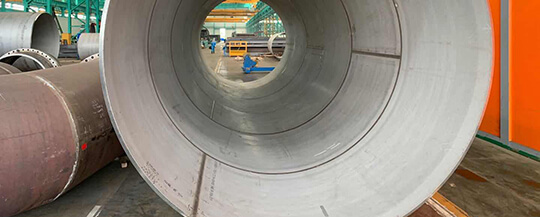The fiber-wound composite pressure vessel is generally composed of an inner lining layer, a fiber reinforcement layer and an outer protective layer.
1. Inner lining
The inner lining layer is in direct contact with the medium, and its main functions are reinforced fiber winding core mold, air tightness, anti-corrosion, high temperature and high pressure resistance, and partial internal pressure bearing, while providing an external interface interface. Therefore, the selected lining material must have good air tightness, corrosion resistance and sufficient bearing capacity. Metal lining and plastic lining are two commonly used lining materials. The composite material pressure vessel lining material used in aerospace generally uses metal lining. Its main advantages are: seamless structure, which can effectively prevent gas leakage; after pre-tensioning the pressure vessel, it can effectively improve its bearing capacity And prolong the life of cyclic fatigue; the strength of the metal itself is relatively high, and it will not sink inward or form cracks because the internal pressure suddenly drops to zero after the medium is released; general metals have good stability, heat and humidity, etc.
2. Fiber reinforced layer
The fiber-reinforced layer is the main load-bearing component (the pressure load to be borne) in the composite pressure vessel. It is composed of a fiber reinforcement and a resin matrix. The fiber bears the main load, and the resin serves to bond the fiber and transfer the load. Therefore, in order for the container to have a good load-bearing capacity, it is necessary to choose high-strength, high-modulus, low-density reinforcing fibers and good performance resin matrix.
Carbon fiber, Kevlar fiber and glass fiber are several commonly used fiber reinforcement materials.
Carbon fiber is made of man-made chemical fiber through oxidation, carbonization, graphitization and other processes, and its carbon content is generally more than 90%. It not only has the characteristics of high temperature resistance, friction resistance and corrosion resistance of general carbon materials, but also high specific modulus and specific strength. Due to the excellent performance of carbon fiber, it has been widely used in cutting-edge technology fields such as aviation and aerospace. Automobiles, sports equipment and sports goods are also widely used. At present, the reinforcing material in composite pressure vessels is mainly carbon fiber.
Kevlar fiber, or Kevlar fiber, was born in the late 1960s and is also called aramid fiber in China. It is a new high-tech synthetic fiber. Kevlar fiber is a trade name produced by DuPont. Kevlar fiber not only has super high modulus, high strength and other mechanical properties and excellent properties such as acid and alkali resistance, high temperature resistance, and small specific gravity, but also has excellent insulation, flame retardancy, radiation resistance and anti-aging properties, and its life cycle long. It is widely used in aerospace, shipbuilding, bulletproof products, special protective clothing, electronic equipment, textile industry and other fields. Glass fiber is an inorganic non-metallic material made of glass. It is a fiber thinner than human hair. It is the first fiber developed and used. The production method is mainly based on glass as a raw material, heated to a molten state, and then subjected to drawing, Manufactured by winding, weaving and other processes. It has the characteristics of good insulation, strong heat resistance, good corrosion resistance, good impact resistance, high mechanical strength and low price. Fiberglass products are widely used in the national economic fields such as transportation, electronics and construction. At present, China's technology for preparing high-strength glass fibers has reached the international advanced level.
3. Outer protective layer
The main function of the outer protective layer is to improve the impact resistance of the composite pressure vessel, which can absorb part of the energy generated by the impact, thereby protecting the fiber from damage. Usually, materials with good impact resistance are selected and wound on the outer surface of the fiber reinforced layer, and then the outer surface is coated.
